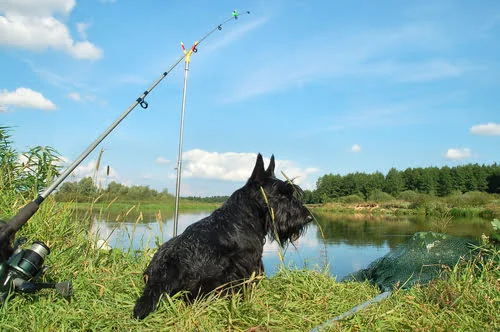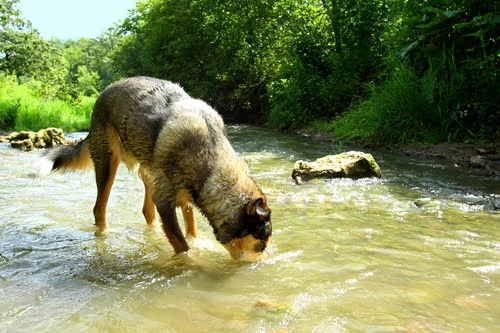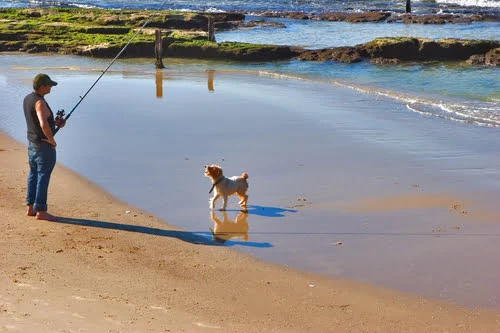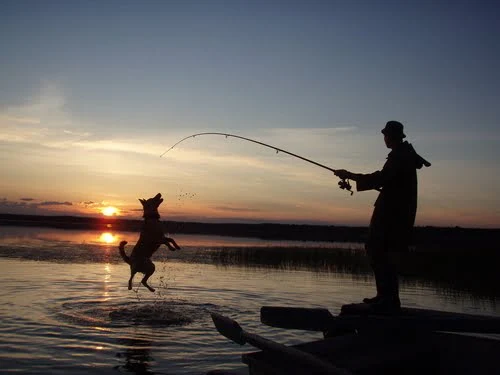There are three things I love – fishing, my dog Roscoe, and fishing with my dog Roscoe.
If you like to fish and have thought about bringing your best friend along for an afternoon down by the river, then keep reading for some helpful tips to make it a safe and successful outing.
Table of Contents
- Can You Take A Dog Fishing?
- Consider The Location And Surroundings
- Training and Preparedness Are Key
- Safety Tips
- Be Courteous of Other Anglers
- What To Bring
- Will My Dog Bite My Catch?
- Conclusion
Can You Take A Dog Fishing?
Taking your dog fishing is a great bonding activity and your pup will love the opportunity to frolic in nature.
But before heading out to the lake, make sure your pup is ready for it. Although dog breed and temperament can be important, nothing tops preparedness.
Training, experience, and socialization are critical for a successful fishing trip!
Ensure your dog is comfortable outside and obeys basic commands before starting any new trip.

Consider The Location And Surroundings
The most important thing to consider when bringing your furry friend along for a fishing trip is the location.
Bringing a dog may limit your fishing spot choices, but the safety of your dog is the number one factor.
Here are some tips we recommend when choosing a good fishing location:
- Avoid busy or highly populated areas (with dogs and people)
- Avoid areas with river crossings, waterfalls, or fast-running water
- Avoid areas with known dangerous wildlife (venomous snakes, porcupines, coyotes, bears, etc.)
- Avoid hazardous areas such as sharp rocks, high debris areas, or areas with stickers and thorns
- Be aware of local vegetation and know which ones can be harmful or poisonous to your dog
- Monitor temperatures and look out for signs of freezing or overheating.
- Don’t forget to check out the rules and regulations for each location to know exactly where your dog is allowed.
Environmental Considerations
While you might see your dog as your pet and best friend, the local wildlife might see him as dinner or a threat.
Keep your dog on a leash when exploring wildlife sanctuaries so as not to disturb the wildlife and also to make sure it doesn’t come after your dog.
If you’re exploring a trail and your dog gets more than a few feet off the path into the brush, call him back to you.

It’s better to leave whatever might be lying undisturbed alone instead of wishing that you had as you rush your dog to the vet.
Lastly, some locations might have seasonal wildlife breeding closures which are periods of time when dogs might not be allowed in the sanctuary or park.
Check with your local Fish and Wildlife or Parks and Recreation departments before going fishing to be sure dogs are allowed at the time.
Training and Preparedness Are Key
A well-trained dog on a fishing trip can be a great asset to have along.
A poorly trained dog running wild along the riverbank and into your favorite honey hole can turn a great day of fishing into a nightmare.
Thorough training, a couple of basic commands, and teaching boundaries can save you from endless headaches on the riverbank.
Begin With The Basics
The first thing you should do to begin training your dog for fishing is to have them master the basic commands of, “no, sit, stay, come, and leave it” while on a long leash.
Using a long leash, in the beginning, allows you to tug gently and regain their attention and focus, should you lose it.
Dogs are curious creatures and you need to be able to reel in that curiosity when it carries them off toward possible dangers like a dropped fly or an open tackle box full of hooks.
Master the basics, not just for good behavior, but ultimately for safety.
Having your dog learn and master the commands while on a leash will help build up their confidence with commands when off leash in the future.
Establish Boundaries
If you want to make your life easier on the river, then train your dog to know where their boundaries are and what areas are off limits.
To achieve this, work with your dog on a long leash to establish a general radius they are allowed to roam when off-leash. Work on leashed recall as well, so they learn how far within their radius they can wander before they need to return to you.
If you want to test out your dog’s abilities before you head to the river, take them to local trails or let them loose off-leash in your yard and work on the recall commands that you’ve been training.
Once your dog seems to have them mastered, it’s time to go fishing!
Safety Tips
The biggest danger your dog is most likely to face on a fishing trip is an open tackle box full of shiny objects, just asking to be checked out.
The number one thing you can do to keep your dog safe while fishing is to keep your tackle box closed with the lid secured. Also, don’t leave lures or flies lying around haphazardly.
Always be sure of your dog’s location before casting your line. An errant hook on a flying line is just as dangerous as an open tackle box. A little situational awareness will take you far here.
Some more common sense safety tips are to be sure your dog has plenty of fresh water and a cool place to lie in the shade while you catch that big one.
Always have a life jacket on your dog if he is prone to going for a swim. Choppy water and overexertion can drown even the best swimmers.
Play it safe, so you can have more adventures together in the future.
Lastly, while you might be inclined to continue fishing while your dog runs into the woods to relieve himself, it’s a better idea for you to go with him.
Snakes and all manner of other critters live in the woods and it’s a good idea to keep an eye on your dog while he does his business.
Be Courteous of Other Anglers
If you go to a popular fishing spot, then you are likely to run into other anglers.

As a courtesy to other fishermen, and for the safety of your dog, be sure to bring along a leash in case your dog is still learning voice recall and he’s not quite at 100% for all commands.
If you plan to fish with friends, let everyone know that you’re bringing your dog ahead of time and be sure that everyone is comfortable around dogs.
Nervous people can make dogs nervous, and nervous dogs do stupid and dangerous things. Be proactive and give people a heads up.
Also, if you plan to do any training with your dog around friends, ensure that you tell them that you’re training your dog that day, so no one is sidetracking your progress, feeding him treats, or offering pets at inappropriate times.
Poorly timed treats and pets during training can reinforce the wrong behaviors.
What To Bring
Your dog shouldn’t need much for a day of fishing, but bring along these basic items to guarantee a smooth trip for all involved.
- Long leash
- Water bowl
- Fresh drinking water
- Treats to reward good behavior
- Life jacket
- Favorite toy or chew
- Poop bags
- Dog pack so he can carry his own gear
You can also bring a shorter leash, but the long leash is recommended in case you need to reinforce or remind your dog of his radius.
Toys and something to chew on are always a good idea if your dog has a habit of getting into trouble when he gets bored. An occupied dog is usually a safe dog.
And if you’re going out on a boat, check out our article on what to bring for dogs on a boat!
Will My Dog Bite My Catch?
Dogs are very curious animals and fish are funny-looking creatures. To tame your dog’s curiosity before it gets out of hand, think about introducing your dog to a fish.
To do this, first, make sure that “no” and “leave it” have been mastered to ensure that your fish stays intact. Then, bring a live fish in for your dog to sniff and investigate while keeping the fish wet and limiting its exposure to your dog.

If you fish to feed yourself, then you can let your dog get a supervised closer look at some dead fish once you are home.
While your dog doesn’t have to meet every fish you catch, it’s a good idea to introduce him to the species that you fish for most.
Conclusion
Well, there you have it. How to turn your best friend into your best fishing buddy.
With a little common sense, investment in training, and consideration for other anglers and wildlife, your dog will be ready to go fishing before the next time you head out.
Just don’t let him play with the tackle.
You May Also Like: Taking Your Dog On An Airboat? Here’s What You Should Know

Growing up in Florida, I’ve been surrounded by saltwater my entire life…and I love sharing my passion with others.
To learn more about why I started Saltwater Mecca, visit the ABOUT page.
Thank you for reading this article. Browse around & have some fun!